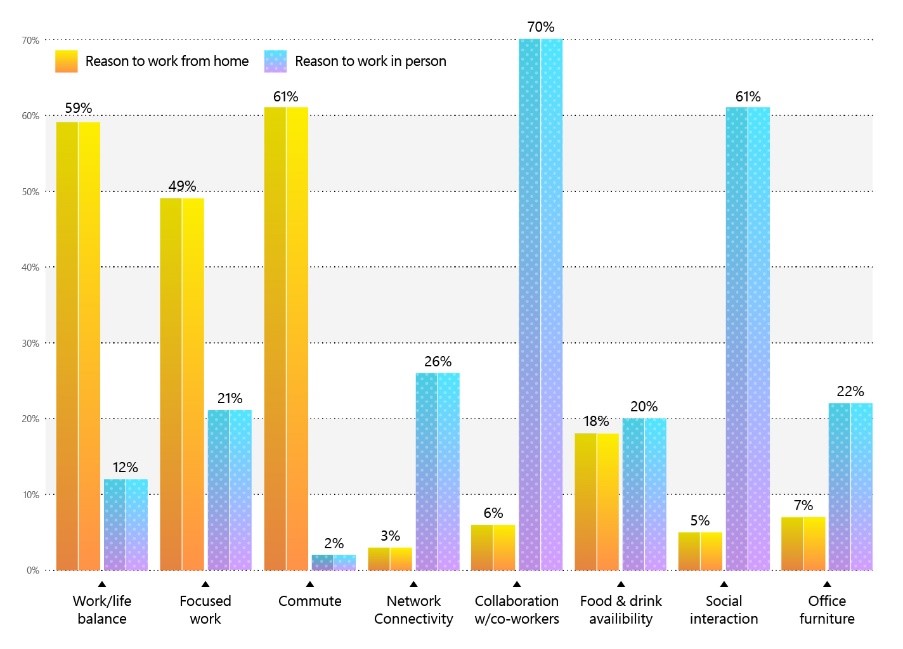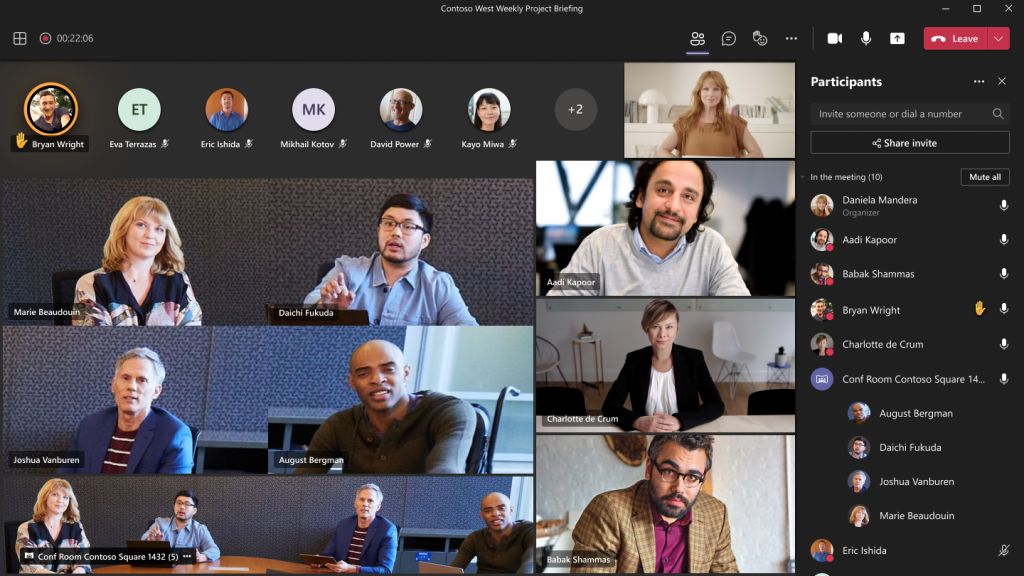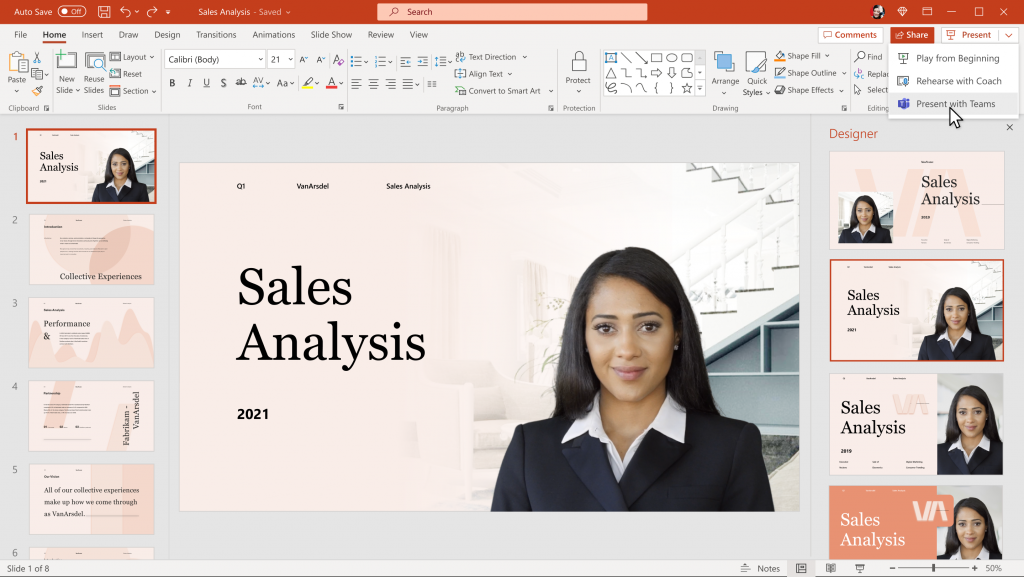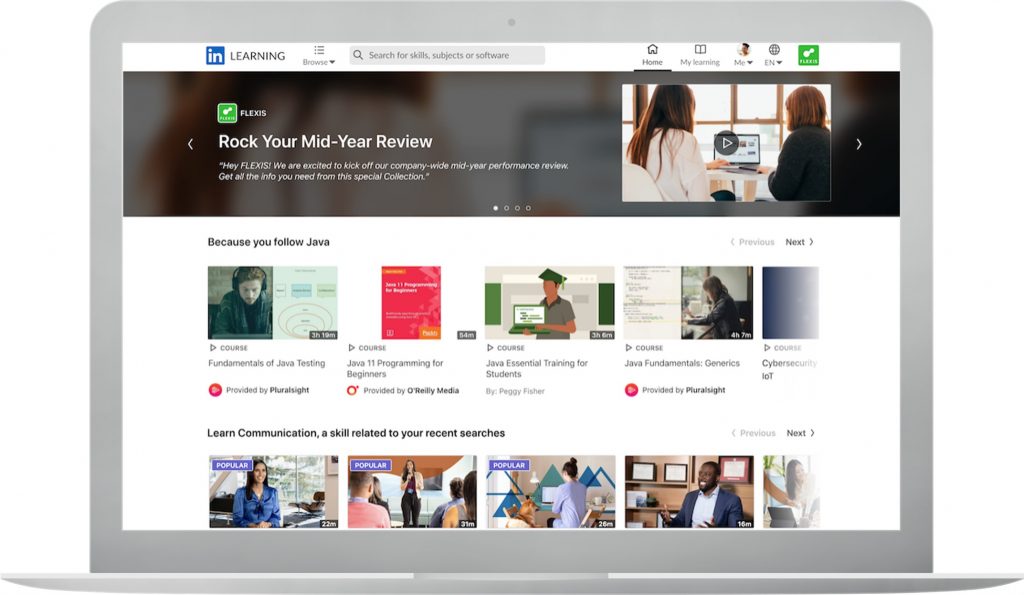This morning Satya Nadella and Ryan Roslansky, the CEO of LinkedIn, sat down to talk about the key secular trends they’re seeing as people and organizations everywhere adjust to hybrid work. Their conversation is part of an effort between Microsoft and LinkedIn to help leaders and their teams navigate this new world of work, and here I’ll share more about the trends we’re seeing, the data behind them and the product updates we’re announcing today across Microsoft Teams, Microsoft Viva and LinkedIn.
As Satya and Ryan mentioned, the evolving Delta variant is compelling many of us to adjust plans for reopening worksites. It’s a stark reminder that this is the new normal. Our ability to come together will ebb and flow. In fact, we had planned for Oct. 4 to be the first possible date to fully reopen Microsoft’s own Redmond headquarters, and many other work sites in the U.S. But as we shared with our employees today, we’ve shifted those plans. Given the uncertainty of COVID-19, we’ve decided against attempting to forecast a new date for a full reopening of our U.S. work sites in favor of opening U.S. work sites as soon as we’re able to do so safely based on public health guidance. From there, we’ll communicate a 30-day transition period that provides time for employees to prepare while allowing us to continue to be agile and flexible as we look to the data and make choices to protect employee health, safety and well-being.
We’ve heard many business leaders come forward with strong opinions on how, when and where people should work in a hybrid world. At Microsoft and LinkedIn, we want to take a learn-it-all approach, and lead with data rather than dogma. And we’re incorporating flexibility into our decision-making. Because in uncharted territory, we need to be able to shift and adjust as data and research offer new insights to guide our way.
The Hybrid Work Paradox and the ‘Great Reshuffle’
A report out today on our Work Trend Index shares what we’re learning from Microsoft employees in over 100 countries around the world. Employee surveys tell us that while hybrid work is complex, embracing flexibility, different work styles and a culture of trust can help us all navigate it successfully. In a year when we sent 160,000 people home to work and remotely onboarded 25,000 new employees, the share of people who report feeling included at Microsoft is at an all-time high of 90%. According to surveys, employee confidence and support from our managers is also at an all-time high. While there is still so much more we can do in our culture journey at Microsoft – and we’d love to see these numbers even higher – this data show that we don’t have to be physically together to feel like we’re in it together.
But there’s no guarantee that these positive trends will continue in hybrid, and difficulties remain. As we navigate remote work during a pandemic, our employee surveys show continued challenges to satisfaction with work-life balance and team connection.
While we hope hybrid work will help us improve in these areas, finding the balance will be complex. Our ongoing research shows employees crave more in-person time with their team but wish to keep the flexibility of remote work. And every person is different – 58% of employees who plan to spend the most and least time in-office are doing it for the same reason: more focused work. And there are gaps to fill – managers plan to spend a higher share of their time in-office than non-managerial employees (45% vs. 39%). Moreover, employees surveyed plan to go into the office more than managers expect. This complexity is what Satya calls the Hybrid Work Paradox.

Solving the Hybrid Work Paradox will be the challenge of the decade. We need policies and technology tuned for flexibility, but policies and technology alone are not enough. Every leader must also ask: How do I rebuild social capital and connection back to mission, culture and team? How do I help people prioritize individual well-being and work in sustainable ways? As Satya has said: “Our new data shows there is no one-size-fits-all approach to hybrid work, as employee expectations continue to change. The only way for organizations to solve for this complexity is to embrace flexibility across their entire operating model, including the ways people work, the places they inhabit and how they approach business process.”
All of this will be key to navigating this moment of change that our colleagues at LinkedIn are calling the “Great Reshuffle.” Leaders are rethinking their working models, cultures and company values, while at the same time, employees are rethinking not only how and where they work, but why. At the core of it all is the start of a new, more dynamic relationship between employers and employees.
To better understand how employers are thinking about navigating this new world of work, LinkedIn surveyed more than 500 C-level executives in the U.S. and U.K. Top of mind for executives is the same thing on the minds of employees – flexibility. With 87% of people saying they would prefer to stay remote at least half the time, a majority of employers are adapting: 81% of leaders are changing their workplace policies to offer greater flexibility.
Despite all the change, leaders feel like there are opportunities ahead – more than half (58%) are optimistic that flexibility will be good for both people and the business. Leaders have an opportunity to rewrite their playbook when it comes to hiring, skills development, engaging talent and more.
Employers and employees have an opportunity to build new relationships grounded in shared values and a common mission. And more people will be doing work that best matches their skills and needs, leading to greater success for organizations that engage their employees with empathy and trust. But the data also underscores the imperative for business leaders to transform themselves to attract and retain top talent as employee expectations evolve.
Taken together, the Hybrid Work Paradox and the Great Reshuffle are creating fundamental changes in the global labor market. Ultimately, no one can predict how things will shake out. But history has shown us that there is always opportunity in turbulent times.
Companies that are adaptable and able to continuously innovate will have the advantage. To really compete, however, they’ll need to enable sustainable productivity for their employees. Right now, the power has shifted from employer to employee, and people will vote with their feet. As conditions change, this pendulum of power will continue to swing in both directions, but two constants remain: First: as Satya said above, every leader and every organization will need to create a new operating model across people, places and processes. And second: those companies with a better employee experience for all employees – from the virtual boardroom to the factory floor – will be the ones to attract and retain better talent.
How technology can help
Microsoft and LinkedIn are navigating the challenges and opportunities of hybrid work just like every other organization. We see the role of technology as an enabler – helping our employees and our customers as they transform for hybrid work and reimagine everything from meetings that transcend space and time to a digital employee experience that everyone can access from anywhere – right in the flow of their work.
Helping every organization have better hybrid meetings
Right now, every leader is grappling with how to have effective hybrid meetings, often with limited equipment and resources. Hybrid meetings are an entirely new kind of meeting and require rethinking how we approach and conduct them to ensure we’re putting every attendee on equal footing, no matter where they’re sitting.
We can all start making hybrid meetings better today with a few good habits, like making sure in-person meeting rooms have a centralized audio device; encouraging everyone to join the Teams meeting – with the camera on – and appointing an in-room moderator to facilitate conversation by monitoring the chat, raise hands feature, and participants unmuting themselves to speak.
New cultural meeting norms are key, but technology can help take the hybrid meeting experience to the next level. Today, we’re announcing new Microsoft Teams Rooms innovations, along with new Teams features, to help you have impactful, engaging hybrid meetings where everyone feels included.
New Teams Rooms innovations
The next wave in Teams Rooms innovation will include a new category of AI-enabled cameras. There are three unique technologies that power this new category of intelligent cameras. The first is AI-powered active speaker tracking, enabling in-room cameras to use audio, facial movements and gestures to detect who in the room is speaking – zooming in for a closer perspective. The next is multiple video streams that allow in-room participants to be placed in their own video pane. The third is people recognition, which will identify and display the profile name of enrolled users within their video pane.

New hybrid meeting features
To make remote presentations more engaging, we’re announcing cameo, a new PowerPoint experience that integrates the Teams camera feed into a presentation to allow the presenter to customize how and where they want to appear on the screen with their slides. As we work to create an inclusive hybrid work culture, where all voices can be heard, speaker coach in Microsoft Teams uses AI to privately share guidance on your pace, notify you if you are interrupting someone and remind you to check in with your audience.
Planning and understanding who will be attending and how they will attend is also key, and today we are announcing a new Outlook RSVP feature that lets people specify whether they will attend in person or remotely. The redesigned Working hours will allow you to include work schedule specifics directly in your calendar, so others can know when and where you’ll be working as we adjust to more flexible work hours and locations.

A digital employee experience – right in the flow of work
Going forward, the digital employee experience is the employee experience. Today, we are announcing the public preview of the Microsoft Viva Connections mobile app, available later this month. Viva Connections provides a single employee app for company communications, news and announcements – all in a personalized feed right in Teams, powered by Microsoft 365. Organizations can customize the dashboard with additional apps to empower employees, making it easier to find useful resources and complete tasks like submitting expense reports, requesting time off from work, or clocking in and out. Powered by adaptive cards, dashboard items can be targeted to specific groups of employees so everyone can stay connected and engaged wherever and however they work.
Our already available Return to the Workplace solution, built on the Power Platform, gives organizations a set of Power Apps and Power BI dashboards to keep employees safe – including vaccine attestation, case management, health screening, facility safety management and more. It’s a turnkey solution that can also seamlessly integrate with existing third-party apps an organization may already have in place. All these solutions are easily incorporated into the Viva Connections experience.
Flexible, safe workspaces for a hybrid workforce
With an increasingly mobile workforce, it’s important for organizations to be able to offer a space for employees who need workspaces where they can touch down either for the day or just a couple of hours to get work done. We’re announcing a new hotdesking experience on Microsoft Teams displays that allow people to locate and reserve flexible workspaces in the office. Employees can book a space from the device or in advance using Outlook or Teams and access their personal Teams calendar, chats, meetings and more. Teams displays can be used as a stand-alone device or as a second screen when hot desking. When an employee signs out, all personal information will be removed from the device.
For more of today’s Teams announcements, please check out the Microsoft 365 blog.
Giving people more choices in how they want to work
To help employers and hiring managers adapt to this new world of work, LinkedIn is rolling out new fields within job postings where organizations can now signal if the open job is remote, hybrid or on-site, helping job seekers search and discover jobs that align with how they want to work. And coming soon, LinkedIn will also have a way for companies to share how they are approaching the future of work on their company page including vaccination requirements, if they plan to go back to an office, stay remote or go hybrid.
Free LinkedIn Learning courses
Investing in new skills is crucial to thriving in today’s workplace – be it in-person, remote or hybrid. To help, LinkedIn has made nearly 40 LinkedIn Learning courses free until Oct. 9, 2021 so that LinkedIn members and HR pros can build critical skills. Whether you’re looking to support your team through the transition to hybrid work or be the kind of manager no one wants to leave, these courses can help you lead through change.
An intelligent skill-building platform to help employers invest in their greatest asset – their people
People are rediscovering how they find meaning and purpose in their lives and at work, and responding by seeking out new opportunities. Leaders, meanwhile, are facing new challenges in retaining and reskilling their people to meet the demands of our new world of work. To navigate these changes, LinkedIn’s skill-building platform, LinkedIn Learning Hub, will be generally available in two weeks. It will help companies build their employees’ skills through personalized content, community-based learning and skill-development insights that will inform their overall learning and development strategy.

Our commitment to customers around the world
Meeting employee expectations, not just to attract and to retain talent, but to enable personal well-being, will be a challenge for every leader and every organization. But if we embrace the data, listen to our employees and customers and incorporate flexibility into everything we do, we believe we can create a better future of work. At Microsoft and LinkedIn, we’ll continue to use what we’re learning to build and improve products designed to empower people for the ways we work today and the ways we’ll work in the future. And we’ll continue sharing what we learn along the way.
The post Microsoft and LinkedIn share latest data and innovation for hybrid work appeared first on The Official Microsoft Blog.
Source: The Official Microsoft Blog